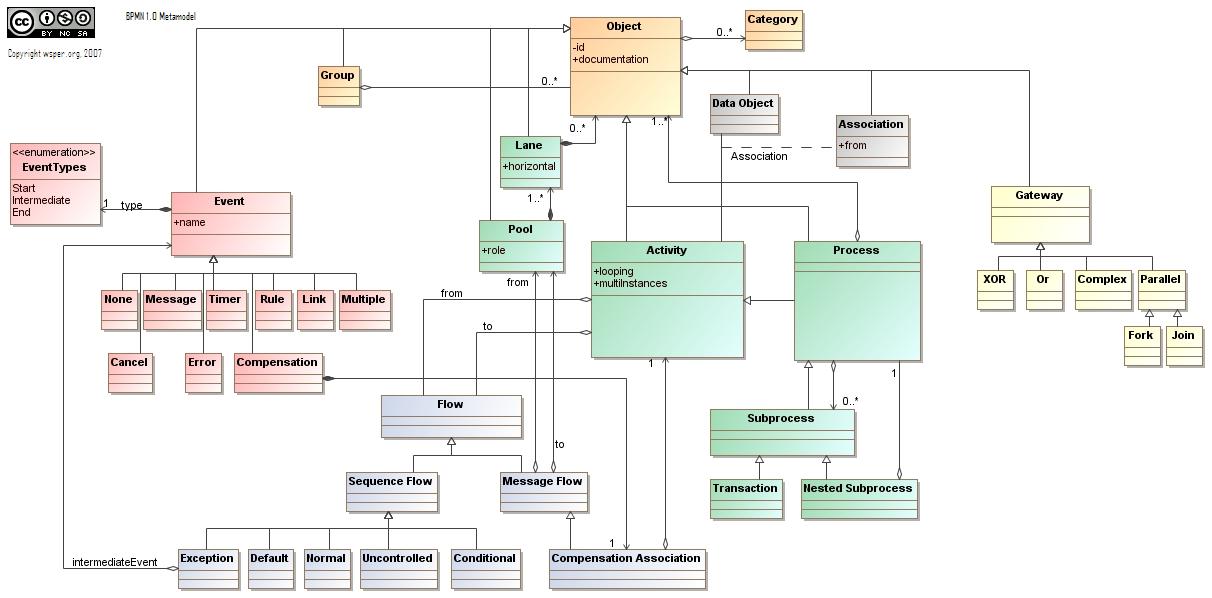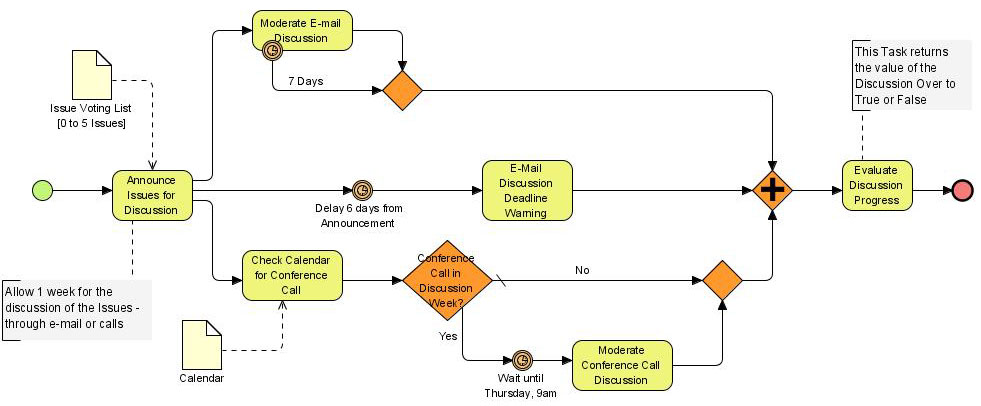BPMN
Introduction
Business Process Modeling Notation (BPMN) is a graphical representation for specifying business processes in a workflow. BPMN was developed by Business Process Management Initiative (BPMI) (Wikipedia).
“The Business Process Modeling Notation (BPMN) specification provides a graphical notation for specifying business processes in a Business Process Diagram (BPD). The objective of BPMN is to support business process management for both technical users and business users by providing a notation that is intuitive to business users yet able to represent complex process semantics. The BPMN specification also provides a mapping between the graphics of the notation to the underlying constructs of execution languages, particularly BPEL4WS. (Business Process Modeling Notation, Wikipedia, retrieved jan 6 2009).”
“PEL is an XML-based language for describing a business process in which most of the tasks represent interactions between the process and external Web services. The BPEL process itself is represented as a Web service, and is realized by a BPEL engine which executes the process description. BPMN is a standard set of diagramming conventions for describing business processes. It is designed to visualize a rich set of process flow semantics within a process and the communication between independent processes. It is intended to support capture of sufficient detail to allow it to be the source of an executable process description. Since BPEL is currently considered the most important standard for execution languages, a translation to BPEL is specified in the BPMN standard. By design there are some limitations on the process topologies that can be described in BPEL, so it is possible to represent processes in BPMN that cannot be mapped to BPEL.” (FAQ, retrieved 16:14, 22 June 2010 (UTC))
See also: The Business Process Execution Language (BPEL), an executable XML language for business processes. Most BPMN tools, in particular BPMN 2.0 versions, can compile drawings into executable BPEL and other XML formats in addition. It seems that while a BPEL process can be represented using BPMN, some BPMN models cannot be represented using BPEL.
History and versions
- BPMN 2.0 RFP: Request for Proposals for version 2.0 of BPMN (2008,-)
- BPMN 1.1: OMG Specification, February, 2008
- BPMN 1.0: OMG Final Adopted Specification, February 6, 2006
- BPMN 1.0: May 3, 2004 Draft Specification
BPMN version 1.x
According to Wikipedia, BPEL has four categories of elements:
- Flow Objects
- Events, Activities, Gateways
- Connecting Objects
- Sequence Flow, Message Flow, Association
- Swimlanes
- Pool, Lane
- Artifacts (Artefacts)
- Data Object, Group, Annotation
BPMN.org divides the BPMN 2.0 notation graphics in six categories:
- Activities
- Events
- Gateways
- Connections
- Artifacts
- Swimlanes
A more difficult meta-model (i.e. an inofficial UML class diagram of BPMN was published by WSPER ("whisper").

BPMN version 2.0
The new revision of BPMN, 2.0 has more than 50 symbols in its full set. In other words, it is a very complex language.
The core set of BPMN 2.0 also can be defined as the set of flow objects, connecting objects, swimlanes and artifacts.
Activities
An activity can be generically described as work that an organization performs.
Events
Events represent something that "happens" during the course of a business process. An event will affect the flow of a process. An event is usually triggered by a cause and it will have an impact (result).
There are three kinds of events:
- Start
- Intermediate
- End
Gateways
Gateways represent decisions, forking and joining of flows.
Conversations
Conversations define message exchanges
Choreographies
Choreographies represent sets of tasks performed by participants
Swimlanes
....
Data
....
Examples

Tools
There seem to exist some free tools (none tested so far)
- Free (totally or somewhat)
- BPMN plugin for Eclipse. Made by Intalio.
- The tool can be download through the Eclipse IDE.
- Oryx, (Signavio) a project to create BPMN 2.0 diagrams, EPCs or Petri nets online. Free for academics.
- OMII-BPEL, Modelling, monitoring, executing scientific workflows with BPEL
- Jadex process. LGPL licence. “The Jadex Processes project provides modelling and execution facilities for workflows. Main focus is on graphical forms of process representation (e.g. the Business Process Modelling Notation - BPMN) and direct execution of modelled processes (i.e. without prior code generation).” ([1]). This is part of a larger project. Jadex is a Belief Desire Intention (BDI) reasoning engine that allows for programming intelligent software agents in XML and Java.
- Bizagi Process Modeler. Closed source freeware for BPMN 1.x (?).
- Free web tools
- Gliffy supports
- Commercial
- Intalo BPM, includes the interesting Social BPM that combines the BPM design tool with a social portal building framework.
This list is by no means complete, see for the moment:
- BPMN Implementors and Quotes (best link, at OMG)
- Tools (BPM forum, not very complete)
Bibliography and links
Links
- Overviews
- Business Process Modeling Notation (Wikipedia)
- Standards
- BPEL 2.0 (the principal format PBMN can export to)
- Web sites
- BPMN.org Information Home Page, e.g.:
- BPMN FAQ at pbmnforum.com
- BPM Research Website by Michael zur Muehlen (blog)
- BPMS Watch by Bruce Silver (blog)
- Posters
- BPMN 1.1 Poster
- BPMN 2.0 Poster (Printable A1 PDF for various languages)
- BPMN 1.x poster from Bizagi.
- Introductions/tutorials
- [http://www.bizagi.com/docs/Workflow%20Patterns%20using%20BizAgi%20Process%20Modeler.pdf Modeling Workflow Patterns through a Control-flow perspective using BPMN and
the BPM Modeler BizAgi] by Marcus Goetz, Institute of Applied Informatics and Formal Description Methods University Karlsruhe (TH).
Bibliography
- White, Stephen A. (2004). Introduction to BPMN, IBM. (Also here.
- White, Stephen A. (2004). Mapping BPMN to BPEL Example, IBM PDF
- Silver, Bruce (2009), BPMN Method and Style, Cody-Cassidy Press, ISBN 0982368100 (author's book home page).